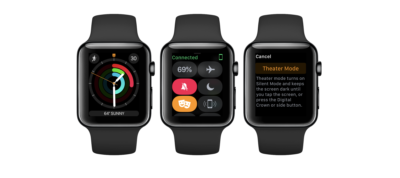Apple Releases WatchOS 3.2 With New Theater Mode And SiriKit Support
Apple has today released watchOS 3.2 to the public. watchOS 3.2 includes support for Theater Mode, and SiriKit applications.
Here’s how Apple describes Theater Mode:
Theater Mode lets users quickly mute the sound on their Apple Watch and avoid waking the screen on wrist raise. Users still receive notifications (including haptics) while in Theater Mode, which they can view by tapping the screen or pressing the Digital Crown.
SiriKit was announced alongside iOS 10 originally, and is now available on the AppleWatch. SiriKit is an API that allows developers to integrate Siri into their applications. This means users can ask their Apple Watch, “Send $100 to Josh using PayPal,” for example.

